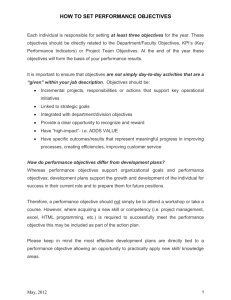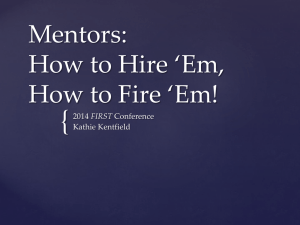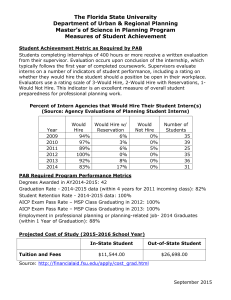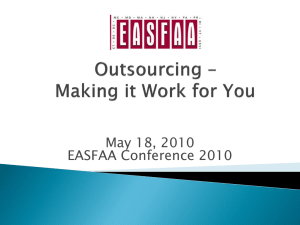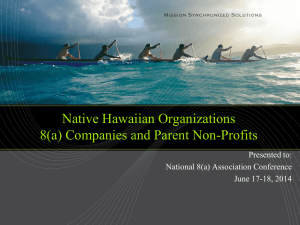Best Practices in New Hire Orientation
advertisement
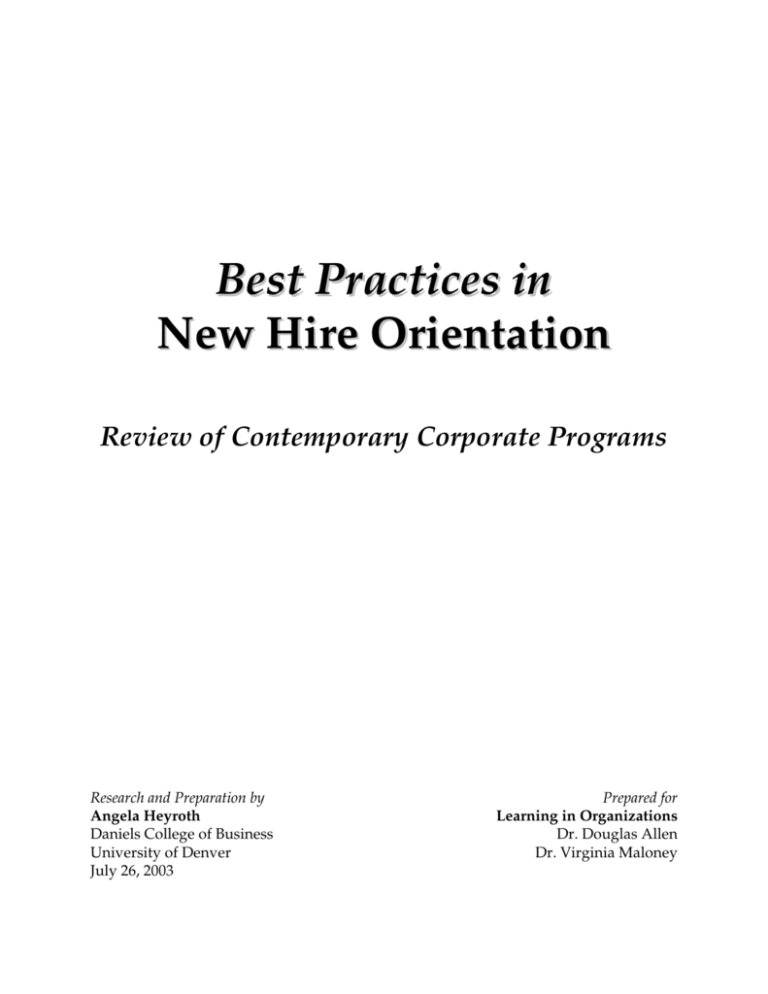
Best Practices in New Hire Orientation Review of Contemporary Corporate Programs Research and Preparation by Angela Heyroth Daniels College of Business University of Denver July 26, 2003 Prepared for Learning in Organizations Dr. Douglas Allen Dr. Virginia Maloney Best Practices in New Hire Orientation - Angela Heyroth Table of Contents The Importance of New Hire Orientations............................................................................ 2 Best Practices They are Engaging ...................................................................................................................... 3 Key Recommendations.............................................................................................................................. 3 They Involve Senior Leaders .................................................................................................... 3 Key Recommendations.............................................................................................................................. 4 They Create a Shared Vision .................................................................................................... 4 Teach new hires to ‘live the values’ .................................................................................................... 4 Provide contextual reference................................................................................................................ 4 Key Recommendations.............................................................................................................................. 5 They are Welcoming and Enfolding ....................................................................................... 5 Celebrate through welcoming activities............................................................................................. 5 Anticipate needs and arrange for productivity tools. ...................................................................... 5 Key Recommendations.............................................................................................................................. 6 They are Part of a Talent Value Chain.................................................................................... 6 Begin orientation with the interview .................................................................................................. 6 Provide pre-orientation materials ....................................................................................................... 7 Create formal follow-up systems ........................................................................................................ 7 Key Recommendations.............................................................................................................................. 8 Building Extraordinary Orientation Programs...................................................................... 8 References...................................................................................................................................... 9 Appendix: Organizational Profiles......................................................................................... 11 Page 1 Best Practices in New Hire Orientation - Angela Heyroth Introduction: The Importance of New Hire Orientations New hire orientation (NHO) programs have become almost a rite of passage in corporations today. But, too many companies use NHO only as a way to inculcate new employees in company policies and procedures, leading to programs that are “overwhelming, boring, [and leave] the new employee … to sink or swim” (Brown, 2003, para. 1). Such NHO programs result in lower productivity and lower retention rates (ibid and Sullivan, 1998), affecting the bottom line. Because future success and a sustainable competitive advantage are exclusively gained through well-trained talent who are dedicated to the organization (Senge, 1990; Meister, 1998; Bartlett and Ghoshal, 2002; Drucker, 2002; Ruggles, 1998), companies should consider NHO as part of their learning and knowledge transfer processes, with the same commitment and enthusiasm that these latter programs often receive. In order to apply these concepts, this paper synthesizes discussions with human resource development professionals at eight very different companies (see Appendix for company profiles) into a set of best practices for NHO programs. Companies profiled are: • • • • • • • • Arrow Electronics Gart Sports Keane Consulting Group Level 3 Communications Motorola Inc. Qwest Communications Republic Financial Corporation Ritz-Carlton Hotel Company* In addition to speaking with human resource professionals, when possible I also spoke with new hires regarding their perceptions of the NHO program. Based on these discussions, I have found that for NHO to be successful in increasing productivity and retention rates and in quickly integrating new hires into the knowledge transfer processes of the company, the best NHO programs have these elements in common: 1. 2. 3. 4. 5. They are engaging; They involve senior leaders; They create a shared vision; They are welcoming and enfolding; and They are part of a talent value chain. Each of these best practices is further enumerated below along with key recommendations for companies planning to implement or change an NHO program. * Note: Information for Ritz-Carlton is from the referenced case from Harvard Business School and is not based on a personal interview. Page 2 Best Practices in New Hire Orientation - Angela Heyroth Best Practice 1: They are Engaging Many NHO programs are rushed or simply just boring. Instead, they should be the company’s time to shine, to demonstrate their commitment to learning and veteran employees’ enthusiasm for the company through compelling programs. Creating an engaging presentation utilizing various training techniques, beyond simple PowerPoint-driven lectures, allows an organization to produce “smoother transfers of [corporate] best practices [which] yield impressive gains in productivity” among new hires (Garvin, 2000, p. 10). The most appealing, and therefore most effective, NHO programs involve creative, compelling group activities. Both Keane Consulting Group and Arrow Electronics use role playing to help new hires understand key concepts. Keane Consulting Group adds levity to the activity by using a trainer with a squirt gun to simulate an angry client. Patti Thill at Qwest Communications facilitates a group activity called the Quick Start Quiz near the end of NHO to ensure that participants learned main points, and Motorola utilizes several team activities and deliverables throughout their NHO program. True “learning requires action” (Garvin, 2000, p. 11) and plenty of planned activities, utilizing all aspects of the “learning pyramid” – lecture, reading, audio-visual, demonstration, discussion groups, and practice by doing (Meister, 1998). Key Recommendations Create interesting, compelling programs that move beyond lecture to stimulate knowledge transfer. • Include group activities such as role plays and team games in NHO programs Best Practice 2: They Involve Senior Leaders While HR may design NHO and be responsible for the majority of its delivery, “management has to take an active, supporting role” (O’Dell and Grayson, 1998, p. 169) for it to be successful in its goals of developing a productive, dedicated workforce. Companies are using senior leadership in various ways during NHO programs. The first half hour of the NHO at Qwest Communications is a presentation from a member of the executive team. Patti Thill with Qwest comments that this “makes the new hires feel like the company is buying into their selection and to the orientation process.” At Motorola, new hires are treated to lunch with a vice president, and at Keane Consulting Group , the president of the division greets every new hire and is involved during the entire recruiting process. The president and COO of the Ritz-Carltongreets new employees on day one of NHO with a stirring address (Sucher and McManus, 2001). Republic Financial’s NHO program involves the entire leadership team, including the CEO, CFO, chief legal officer, and divisional presidents, as active presenters. By involving senior leadership in very visible roles, NHO is elevated from a simple orientation program to its rightful place as the beginning of building a special rapport. It Page 3 Best Practices in New Hire Orientation - Angela Heyroth affirms the new employee’s decision and creates buy-in on both sides of the employment relationship. Key Recommendations Involve senior leadership in NHO programs in a visible way. • Ask executives to welcome new hires at the beginning of the program • Ask executives to present a portion of the program, specifically as it relates to the company’s core business • Ask executives to take part in activities such as group lunches for new hires Best Practice 3: They Create a Shared Vision Successfully recruiting top talent is not enough – once an employee joins a company, NHO should “ensure that those valuable individuals become engaged in the organization’s ongoing learning processes” (Bartlett and Ghoshal, 2002, p. 41). Beyond communicating policies and procedures, NHO should create a shared vision by acclimating new hires into the company culture and values, as well as the overall framework. Teach new hires to ‘live the values.’ By “inculcating everyone … in the culture and values that make the organization unique,” new employees are enabled to ‘live the values’ of their new company (Meister, 1998, unpaginated). Organizations can achieve this in a number of interesting ways. Keane Consulting Group conducts all of their NHO programs in Chicago, their national headquarters. This is true whether there is one new hire or ten. New hire Alicia Dirk found this to be an effective way to be quickly familiarized with the corporate culture. Qwest Communications begins their NHO with a discussion of their mantra Spirit of Service and what it means to employees. Motorola covers the company’s mission statement in depth, as well as the mission statements for individual departments. Level 3 Communications begins NHO with the Level 3 Story, about an hour of time spent introducing new employees to the company’s short history and key facts. The Ritz-Carlton begins NHO with a discussion of corporate values to “align the worker with the mission of the company” from the beginning. The vice president of HR explains that, “if you waste the first few hours [of NHO] discussing anything other than values, you’re wasting your opportunity.” (Sucher and McManus, 2001, p. 11) All of these techniques serve to create a sense of pride among new hires and encourage them to ‘live the values.’ Provide contextual reference. It is important for new hires to understand the company’s framework and place in the industry, so that “they can understand how important their roles are in meeting the company’s business objectives and profit goals” (Meister, 1998, unpaginated). Gart Sports introduces new hires to the company’s core business by requiring all corporate hires to work in a retail location for one day during their first month of employment. During the day, they unload a truck, stock merchandise, work the registers, and complete other storerelated duties, which they may never again perform. Amanda Giltner says that this part of the program provides new hires a perspective on the company and their jobs. “We’re all here at the corporate office to support the people in the stores, and this program gives all new hires a personal connection to the stores and an understanding of the big picture of why we’re in business.” Keane Consulting Group spends two days out of a three day orientation Page 4 Best Practices in New Hire Orientation - Angela Heyroth introducing new hires to the firm’s consulting process, including meeting facilitation, process implementation, client development, work flow diagramming, and other skills specific to consulting and to the firm’s methodology. Arrow Electronics provides an overview of their unique electronics components industry to new hires through various group activities and role plays. Republic Financial provides context by discussing each major business line of the company with new hires, while Level 3 Communications takes each person through the Network Operations Center, to introduce new hires to the core business of the company. These types of activities serve to break down silos and “corporate villages” before they are constructed (O’Dell and Grayson, 1998, p. 157). While it is clearly important to cover such company guidelines as time reporting, parking procedures, and a benefits overview, these companies realize that NHO should involve much more than these concepts, instead using them as vehicles to engage the new hire into the company’s values and core business. Key Recommendations Use NHO to create a shared vision by introducing new employees to company values and frameworks. • Create pride in the new employee by introducing them to company history, mission, and values • Help new employees understand the core business through skill training, an overview of the lines of business, and an indoctrination into the company’s reason for being Best Practice 4: They are Welcoming and Enfolding Everyone can probably remember the feeling of walking into a new organization and feeling lost. The best NHO should be designed to assist new employees in overcoming this emotion by enfolding them into the company from the beginning. They can do this by creating a welcoming, almost celebratory environment, and by making people feel like productive members of the organization immediately. Celebrate through welcoming activities. Ritz-Carlton begins its seven-day NHO with “what can only be described as a pep rally,” then as the new employees enter the building, they are greeted with “enthusiastic applause” (Sucher and McManus, 2001, p. 12). Craig Howell of Level 3 Communications arranges for new employees to receive a gym bag emblazoned with the Level 3 logo, which is filled with more paraphernalia, such as pens. Amy Gray-Brown at Republic Financial sends every employee a Harry & David gift basket prior to their first day of work. She also arranges to have the new hire’s department accompany them to lunch on their first day and closes the second day of orientation with a company-wide welcome to all new hires through a casual gathering over milk and cookies. New hire Greg Mitarotonda says that, “the recruiting and first-day activities went far to make me feel welcome.” Both Republic Financial and Gart Sports provide detailed facility tours, including introductions to key people, as a way to enfold new hires into the organization and celebrate their arrival. Anticipate needs and arrange for productivity tools. If new employees feel productive on day one, they feel welcome on day one. To feel productive, new employees need to have Page 5 Best Practices in New Hire Orientation - Angela Heyroth access to the tools and company assets that they will need to perform their job, such as a computer and phone, email access, a desk, phone list, and other necessities. Also helpful to have on day one, or at least week one, are business cards, a nameplate, and other personalized items which enfold a new employee into the organization. Arrow Electronics succeeds in having productivity tools available to about ninety percent of their new hires on the first day of work. Republic Financial also has productivity tools – and the IT training to go with them – available on day one. Amanda Giltner of Gart Sports says that she designed the NHO program to answer all the questions that she did not think to ask on her first few days, including providing a pictorial telephone directory and software training. Gart new hire Robbi Driggers said that it was “nice to come in on my first full-day of actual work and feel like I knew what was going on.” Such arrangements allow new employees to be productive immediately. “One reason people change jobs is because they never feel welcome or part of the organization they join” (Brown, 2003, para. 4), and having a celebratory environment and productivity tools ready are two ways to make NHO a welcoming and enfolding, and therefore successful, experience. Key Recommendations Ensure that new hires are welcomed on their first day with celebrations and the tools necessary to do their jobs. • Mail a welcome gift prior to NHO • Provide company-logo paraphernalia such as pens and T-shirts during NHO • Create a celebration activity like a company-wide welcome party or departmental lunch • Provide detailed tours of the facility • Arrange for as many productivity tools and other assets to be available on day one as possible • If not available on day one, let the new employee know when their tools will arrive and provide temporary tools in the mean-time • Provide training on these tools and assets Best Practice 5: They are Part of a Talent Value Chain Training is not a one-time program; it is a process (Davis and Davis) which begins with recruiting, and continues through to interviewing, the offer process, orientation, and ongoing knowledge transfer. The best NHO programs are those that acknowledge that they are one step in this value chain of “attracting, developing, and retaining individuals with the skills, perspective, and experience necessary to drive a global business” (Meister, 1998, unpaginated). This is accomplished by beginning orientation prior to day one and continuing it with future follow-up. Begin orientation with the interview. As Nancy McBride with Arrow Electronics expresses, “new hire orientation starts with the first interview.” She works to ensure that interviewers are trained to carefully introduce key concepts about the company during the interview stage. Keane Consulting Group also begins orientation during interviewing and recruiting. In fact, a cultural interview is one of the steps a candidate passes through before Page 6 Best Practices in New Hire Orientation - Angela Heyroth being considered for hire. During that interview, the interviewer discusses the firm’s mission and culture, and determines if the candidate is a strong fit. At the Ritz-Carlton Hotel, candidates are treated to a “personal demonstration of the service-oriented culture that [has] made The Ritz-Carlton famous” (Sucher and McManus, 2001, p. 10), with an orchestra playing during interviews and with each candidates presented with a personal box of Ritz-Carlton chocolates. By introducing key concepts during the interviewing stage, companies have begun NHO during recruiting and have tied it to a broad value chain. Provide pre-orientation materials. After the offer has been accepted, many companies, including Arrow Electronics, Gart Sports, Motorola, and Republic Financial send preorientation materials to new hires prior to their first day. Such materials include a benefits packet, area guide (restaurant information, etc.), and tips from current employees for surviving the first few weeks. Greg Mitarotonda, Republic Financial new hire, commented that the preorientation materials provided him “virtually limitless access to all the information I needed, and it definitely helped me to figure out what I was getting into before my first day.” Robbi Driggers, Gart Sports new hire, said that she appreciated receiving benefits information prior to orientation because “I came to my first day equipped with questions instead of hearing the information for the first time.” Level 3 Communications has uploaded all of their NHO materials to their intranet, and provides links to these materials prior to the NHO program. These steps allow new hires to become familiar with the key points of orientation before the process begins. Create formal follow-up systems. An additional technique many forward-thinking companies use is to provide structured follow-up to new hires following NHO programs. This follow-up takes multiple forms, such as formal programs, assigned mentors, hiring manager clarification, and reference materials. Amanda Giltner, with Gart Sports, has designed a Hiring Manager Checklist, which extends the NHO process to the first month of the new hire’s employment. The checklist includes a departmental tour, specific job training, and other such items. Amy Gray-Brown at Republic Financial has designed a two-tier NHO process. On their first day at work, a new hire goes through typical orientation processes covering policies and procedures, but this is followed up by a more extensive day-long program several weeks into their new job, once they have begun to “settle in.” Motorola follows their two-week to one month long NHO program with their famous offerings from Motorola University, as well as an assigned mentor. Keane Consulting Group also uses a mentorship model, providing each new employee with a seasoned employee to act as a New Hire Buddy. Theresa Webster explains that this mentor is asked to get together with the new hire three times over the new hire’s first six months with the company. Anna St. Catherine, a recent hire with Keane Consulting Group, says that her mentor provided excellent insights regarding company culture, norms, and politics, and provided her with some early coaching. Such facilitated mentoring creates “a continuous learning climate” (Murray, 1999, p. 546). Keane Consulting Group also provides further firm-wide training four times per year, an extension of the NHO program. Additionally, all companies I spoke with provide a fairly extensive packet for future reference. Such follow-up allows NHO to be integrated into a long-term talent development process rather than a one-time program. Follow-up helps to integrate the new hire rather than Page 7 Best Practices in New Hire Orientation - Angela Heyroth putting them in a “sink or swim” situation, which often leads to either lower productivity or higher attrition, either of which affect the bottom line. The talent value chain begins with recruiting and continues through to orientation and future knowledge sharing. It integrates selection and staffing with training and career development (McLagan, 1989) and ensures that new employees are invested in immediately. Key Recommendations Orientation should not be a one-time program. Instead, treat it as a long-term process that begins with recruiting and continues through the employee’s entire tenure. • Train hiring managers to introduce key concepts about the company during interviewing • Provide detailed pre-orientation/survival packets that can be reviewed prior to the first day; contents should include not only benefits materials but also information related to the best places to eat in the area, key tips from employees, and a welcome letter from the leadership team • Create a structured follow-up system involving HR/training, hiring managers, and a facilitated mentoring process Conclusion: Building Extraordinary Orientation Programs Not one of the NHO programs discussed above is “the perfect” program, but all are innovative and progressive in some of their practices. Each person I spoke with told me that their program could use improvement, and indeed, that understanding is one of the major strengths of each of these programs – they are constantly changing and evolving as the business changes or as feedback is studied. The key to an effective NHO is to “focus on affirming the new employee’s decision to come on board, conveying a sense of the company’s culture and making the new recruit feel a productive part of a team as soon as possible” (Garvey, 2001, para. 3). By improving NHO, companies can increase retention by 25 percent (Sullivan, 1998), as well as integrate a new hire quicker, thus improving productivity and contributing thousands of dollars in bottom line savings. Over the next few years, it is predicted that the war for talent will begin again, once baby boomers start retiring en masse and a smaller generation replaces them in the workforce, creating a major talent shortage in the United States (Martinez, 2003). When this challenge in recruiting recommences, it will be the companies who have been known as top talent developers that will be most successful in securing the most in-demand candidates. How do you acquire such a reputation? Start with creating new hire orientation programs that emulate best practices. Page 8 Best Practices in New Hire Orientation - Angela Heyroth References Bartlett, C. & Ghoshal, S. (2002, Winter). Building competitive advantage through people. MIT Sloan management review (43)2, p. 34-41. Brown, J. (2003). Employee orientation: Keeping new employees on board. Retrieved online 7/13/2003 from http://humanresources.about.com/library/weekly/uc042102a.htm. Davis, J. & Davis, A. Effective training strategies. San Francisco: Barrett-Koehler Publishers. Drucker, P. (2002, February). They’re not employees, they’re people. Harvard Business Review. Garvey, C. (2001, June). The whirlwind of a new job. HRMagazine [online version]. Garvin, D. (2000). Learning in action. Boston: Harvard Business School Publishing. Marquardt, M. (1996). Building the learning organization. New York: McGraw-Hill. Martinez, M. (2003, Summer). What does the future hold for staffing? Employment management today (8)3, p. 7-9. McLagan, P. (1989). Models for HRD practice. Alexandria, VA: American Society for Training and Development. Meister, J. (1998). Corporate universities: Lessons in building a world-class work force. New York: McGraw-Hill. Murray, M. (1999). Performance improvement with mentoring. Handbook of human performance technology, 2nd ed. San Francisco: Jossey-Bass Pfeiffer. O’Dell, C. & Grayson, C.J. (1998, Spring). If only we knew what we know. California management review (40)3, p. 154-174. Ruggles, R. (1998, Spring). The state of the notion: Knowledge management in practice. California management review (40)3, p. 80-89. Senge, P. (1990). The fifth discipline. New York: Doubleday. Sucher, S. & McManus, S. (2001). The Ritz-Carlton Hotel Company. Boston: Harvard Business School Publishing. Sullivan, J. (1998). The new hire orientation toolkit. Gately consulting. Retrieved online 7/13/2003 from http://ourworld.compuserve.com/homepages/gately/pp15js24.htm. Page 9 Best Practices in New Hire Orientation - Angela Heyroth Interviews: Arrow Electronics Nancy McBride Human Resources 303-824-4190 | nmcbride@arrow.com 7/14/2003 Level 3 Communications Craig Howell Human Resources 720-888-8119 | craig.howell@level3.com 7/22/2003 Gart Sports Amanda Giltner Training Coordinator 303-864-2156 | agiltner@gartsports.com 7/10/2003 Motorola Inc. Name withheld due to confidentiality 7/14/2003 Gart Sports Robbie Driggers 7/17/2003 Qwest Communications Patti Thill HR Manager 303 965 6050 | pthill@qwest.com 7/15/2003 Keane Consulting Group Theresa Webster HR Manager (303) 584-9796 | Theresa_M_Webster@Keane.com 7/11/2003 Republic Financial Amy Gray-Brown Human Resources (303) 751-3501 | agraybrown@Republic-Financial.Com 7/14/2003 Keane Consulting Group Alicia Dirk 7/11/2003 Republic Financial Greg Mitarotonda 7/14/2003 Keane Consulting Group Anna St. Catharine 7/11/2003 Page 10 Best Practices in New Hire Orientation - Angela Heyroth Appendix: Organizational Profiles† Size Primary Industry Number Employees ---2002 Revenue Arrow Electronics Electronic Components 11,700 $7,390.2 million Gart Sports Retail 7,100 $1,051.2 million Keane Consulting Group Management Consulting 7,331 $873.2 million (Keane Inc.) Level 3 Communications Telecommunications Services 6,275 $3,148.0 million Telecommunications Equipment Telecommunications Services 97,000 $26,679.0 million 50,7888 $15,487.0 million Republic Financial Corporation Investment Portfolio 115 privately held Ritz-Carlton Hotel Company Hospitality Motorola Qwest Communications † 144,000 $8,441.0 million (Marriott Inc.) Industry and size information from Hoovers.com Page 11 NHO Notes Version 1: 4 days at corporate headquarters in Melville, New York Version 2: Day one with hiring manager; day two with HR (depends on budget) One day in corporate office on first day of employment plus one day at a retail location during first month of employment 3 days at corporate headquarters in Chicago, Illinois – first three days of employment Half-day in Broomfield, Colorado location (employees at other locations join remotely) during first month of employment Two weeks to one month – immediately following offer Half-day in Denver, Colorado on first day of employment First day of employment split with HR and with department and later one day corporate-level orientation with leadership team (quarterly) Seven day “countdown” prior to new hotel opening
